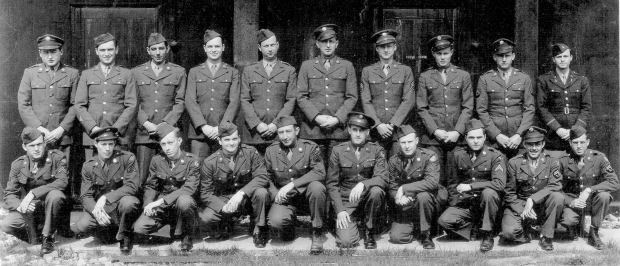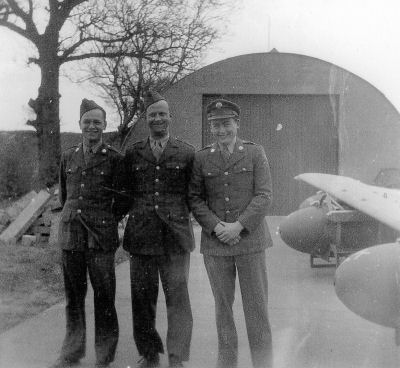 |
Special Weapons Glide Bombs |
Personnel
Mission Reports

Special Weapons Section - 14 August 1944
Sgt Robert D. Brassil (back, far left); 1Lt Joseph E. Rose (back, far right)
Sgt Milton W. Bigley (back, next to Rose); Sgt James H. Fisher (front, far right)
- click the image for a larger view -
TOP SECRET GLIDE BOMB PROJECT
by Robert D. Brassil
(from Hell's Angels Newsletter, Feb 2003)
 Special Weapons Group Members Jim Fisher, Clarence Balder and Bob Brassil. Glide Bombs are partially visible at the right. |
Most of the German submarines that caused the enormous Allied shipping losses operated in "wolf packs" out of heavily fortified ten-to-twelve feet thick steel reinforced concrete pens at French coastal cities such as St. Nazaire. Initial RAF and later Eighth Air Force bombing attempts on these important targets in the late months of 1942 met with stiff German resistance. There was heavily concentrated and accurate fire from anti-aircraft gun emplacements and fierce combat pursuit by top Luftwaffe fighter squadrons. Eighth Air Force bomber losses were heavy.
The use of a 2,000-lb glide bomb was a possible way to defeat these concentrated coastal defenses. The assembled, gyro-controlled bomb had a fixed gliding angle of approximately 5 to 1, allowing it to travel a longitudinal distance of one mile for every thousand feet of pre-release altitude. The idea was to use B-17 bombers with external bomb racks, each carrying two one ton glide bombs. The B-17's would fly to a point over the Atlantic some 20 to 25 miles from the French coast and dive toward the target, releasing the winged bombs to glide into selected submarines pens. Delayed fuses would provide a sideways "bowling ball" type impact to cause additional damage by the tumbling one-ton bombs prior to explosion.
I was one of fifty men who, after completing Army Air Force AM and Instrument Specialist schools in late 1942, was hastily shipped to Eglin Air Field to learn how to assemble glide bomb units and test their battery energized flight control gyro-mechanisms. After a few weeks of training, we traveled by train to Halifax, Nova Scotia, to join Canadian-trained RAF personnel from Poland and British Commonwealth nations on a midwinter sailing to Liverpool, England on the British troopship Louis Pasteur. Our group of 50 was split-up and attached to separate B-17 groups of the 1 st Bomb Division to await arrival of a priority shipment of the glide bomb equipment. Milton Bigley and I were among the 19 assigned to the 303rd BG.
When the shipment of the glide bomb equipment failed to arrive as scheduled, Bigley and I volunteered for 359th aircraft line assignments and functioned as mechanics until October 1943, when large wooden crates of glide bomb equipment were finally delivered to Molesworth. They were piled on the tarmac behind the 359th Squadron Headquarters building.
With the arrival of the glide bomb equipment, the nineteen of us at Molesworth were assigned to a "Special Weapons Section" under the direction of Lt. Joseph Rose of the 1681 st Ordinance S & M Company. Our immediate job was an expedited effort to unload, assemble and prepare the glide bombs. Each assembled glide bomb had to be hoisted and delicately balanced prior to a final tightening of the two steel bands that attached the glider wing section to the 2,000 pound explosive. About 50 glide bombs were assembled, placed on steel cradles, and stored in an outdoor area of the bomb dump.
The wooden glider section had a fixed wing and a tail assembly containing adjustable twin rudders. A metal "black box" straddled the 4 by 4 twin booms and was located directly behind the wing. A rod connection from the "black box" to the twin rudders allowed gyro controlled servomotors to adjust the flight direction of the released glide bomb. The box also contained a unique, compact sealed 12-volt battery that was specifically developed to supply in-flight electrical current for the gyro and servomotors.
Prior to release of the glide bomb, a spring-loaded switch assembly allowed a retractable rod to be inserted to keep the gyro in a caged, locked or rigid position and the electrical power from the battery switched off. When loaded under the wing of a B17, a retractable electric extension cord supplied B-17 electric current to the "black box" by switching the external bomb rack release switch into a "select" position. It was critical for the caged gyro to be "revved up" and properly spinning for some period of time before the pilot starting his bomb run dive at the target. His B-17 would have to reach the required glide bomb release speed of 190 MPH.
A "salvo" position of the external bomb rack switch would release the glide bomb and simultaneously uncage the spinning gyro and transfer B-17 electrical power to the 12-volt battery. If the assembled glide bomb unit was properly released, the gyro controlled electric servo motors would adjust the twin rudders to return and maintain the "grapefruit" in the selected pre-release flight direction.
In mid October 1943, directly after the 78th mission of the 303rd BG on its second bombing of Schweinfurt, Germany, a number of new flight crews called the "Iseman Group" arrived in England. They had had extensive training in the use of glide bombs on practice targets off the Florida coast. These crews flew 8th Air Force replacement B-17's from the States to three bases and started their regular combat assignments. The 303rd , the 379th and the 384th were the only 8th Air Force Bomb Groups to receive glide bomb equipment and participate in the use of this type of weapon.
In late October and early November, after the glide bombs had been assembled and readied for use, a few practice missions with a limited number of glide bomb releases were flown from Molesworth to North Sea practice bomb sites for the further training of other 303rd bombardiers. As time passed, the Special Weapons Section patiently waited for the "grapefruit" glide bombs to be used against their primary targets, French coastal German submarine pens.
When nothing happened by the middle of January 1944, some of us who had been originally attached to the 303rd, decided to end the idleness and boredom of every day reporting to the bomb dump by returning to squadron ground support duties. Bigley was assigned to the Knockout Dropper and remained as one of its ground crew members through its 75th retirement mission while I worked on a number of different 359th planes including Black Diamond Express, Thunderbird and Eight Ball Mark II.
Months continued to pass with no word of plans for a possible use of the assembled "grapefruit" weapons. By early 1944 the Germans had transferred their main U-boat operational bases to Norway or back to Germany as Allied air power continued to gain superiority in the skies over the coastal areas of France. The relocation of German submarine bases nullified the original plans for glide bomb usage on French Atlantic coastal targets and left the assembled glide bombs to continue to sit on cradles at the 303rd bomb dump site. A change from the original glide bomb targets was indicated by the issuance of a March 14, 1944 "Grapefruit" mission field order, but it was canceled before the identity of the target was known.
In late April 1944 all Molesworth members of the Special Weapons Section were suddenly reassembled for the arming and pre-flight testing of the gyro controlled mechanisms for a mission to the mainland German city of Cologne. That mission on April 26, 1944 was recalled without glide bomb release because of inclement weather over the target area.
A second glide bomb mission to Cologne was scheduled and flown on May 28, 1944, less than ten days before the Allied D-Day invasion. Fifty-eight planes from the 303rd, 379th and 384th were scheduled to fly the "grapefruit" mission. Nineteen of those planes were supplied by the 303rd Bomb Group. It was the Group's 162nd combat participation. In other words, 84 combat missions were flown from Molesworth after the arrival of the Iseman Group. Most of the original Iseman Group Florida trained bomber crews had, by this time, completed their mission quotas or had been lost in combat.
Little, if any, prior training was provided for the majority of the May 28, 1944 combat mission crews, nor were meaningful attempts made to improve critical release conditions for the glide bomb units, resulting in a higher than expected "spinout" or drop out performance. Although over 1 ,300 8th Air Force aircraft flew missions to the Cologne/Rhine River area on that day, the selection of the city of Cologne as a glide bomb target for the small task force of 58 B-17s was never explained.
Approximately 35 "grapefruit" or 32% of the total 109-bomb load units released at 20,000 feet were reported to have traveled about 20 miles and to have hit within the Cologne city limits. The release of glide bombs, some far distance from the city, and their unexpected late arrival at the Cologne target area, must have had a devastating effect on German civilian morale. I have often wondered if the long delayed and one-time use of the glide bomb weapon on a German city was at least some retaliation for the destructive German "Buzz Bomb" attacks on England that began in December of 1943 and grew to over 8,000 launches before finally being stopped by the Allied invasion forces in June and July of 1944.